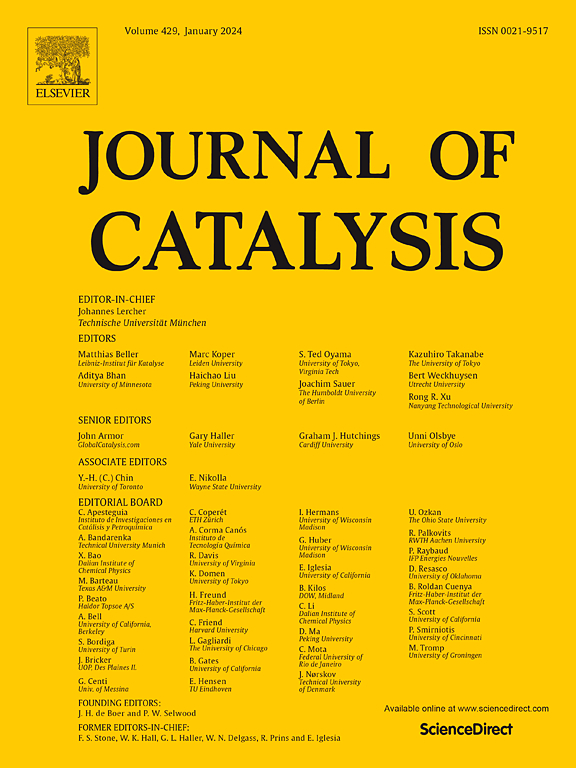Predicting a generalized mechanism of branched alkane hydrogenolysis on Ru, Ir, and Pt surfaces relevant to polymer upcycling applications
IF 6.5
1区 化学
Q2 CHEMISTRY, PHYSICAL
引用次数: 0
Abstract
Here, we present a fundamental study investigating the mechanisms governing C–C hydrogenolysis of branch points within small alkanes on Ir, Pt, and Ru surfaces using Density Functional Theory (DFT). Previous work has shown that activation of unsubstituted C–C bonds occurs through the dehydrogenation of the C–C bond to form a bound alkyne, followed by a kinetically relevant C–C activation and the hydrogenation of the cleaved intermediates to form smaller alkane products. Substituted bonds, in contrast, involve the dehydrogenation of the C–C bond being cleaved, as well as other C atoms near the reacting center. This leads to the counterintuitive observation, that reactions of unsubstituted C–C bonds (having more H to lose) are less inhibited by H2 than reactions of substituted C–C bonds (having less H atoms to lose). These prior studies of branched alkane activation, however, focused on Ir catalysts and on methyl-substituted alkanes and cycloalkanes, such that the impact of catalyst identity or of long branches (i.e., like those found in some polymers) on substituted C–C hydrogenolysis mechanisms is largely unexplored. Here, we consider isobutane activation mechanisms on Ir, Ru, and Pt catalysts, and use these results to predict how a larger branched alkane, 3-ethylpentane, would react, as that molecule is more reminiscent of the branches in polyethylene. DFT-estimated free energy barriers and turnover rates indicate that hydrogenolysis activity and rate inhibition from hydrogen pressure follow a general trend with catalysts following a reactivity trend of Ru > Ir > Pt, where Ru is the most active and most inhibited by H2, with Pt being the least reactive and least inhibited by H2 pressure. By categorizing the isobutane-derived transition states based on whether they are ‘extendable’ to larger compounds, we predict how the size of branches and the alkane backbone influence substituted C–C bond activation (e.g., comparing isobutane to 3-methylpentane or 3-ethylpentane). These data demonstrate why, on Ru, isobutane hydrogenolysis measurements are unlikely to be informative about the mechanisms that activate branches present in polyethylene or polypropylene molecules. This study lays a foundation for a better mechanistic understanding of how branch points activate in alkanes and relates those changes to polymer upcycling via hydrogenolysis.

预测Ru、Ir和Pt表面上支链烷烃氢解的广义机理,与聚合物升级回收应用相关
在这里,我们提出了一项基础研究,利用密度泛函理论(DFT)研究了Ir, Pt和Ru表面上小烷烃分支点的CC氢解机制。先前的研究表明,未取代的CC键的激活是通过CC键的脱氢形成一个结合的炔烃,然后是一个动力学相关的CC激活和裂解中间体的氢化形成更小的烷烃产物。相反,取代键涉及到CC键的脱氢被劈开,以及其他C原子在反应中心附近。这导致了反直觉的观察,即未取代的CC键(有更多的H失去)的反应比取代的CC键(有更少的H原子失去)的反应受到H2的抑制更小。然而,这些先前对支链烷烃活化的研究主要集中在Ir催化剂和甲基取代的烷烃和环烷烃上,因此催化剂的特性或长分支(即,像在一些聚合物中发现的那样)对取代的CC氢解机制的影响在很大程度上是未知的。在这里,我们考虑了异丁烷在Ir, Ru和Pt催化剂上的活化机制,并利用这些结果来预测一个更大的支链烷烃,3-乙基戊烷,将如何反应,因为该分子更容易让人想起聚乙烯中的分支。dft估计的自由能垒和周转率表明,催化剂的氢解活性和氢压抑制速率遵循Ru >; Ir >; Pt的反应性趋势,其中Ru的活性最强,H2的抑制作用最强,Pt的活性最小,H2的抑制作用最小。通过对异丁烷衍生的过渡态进行分类,根据它们是否可“扩展”到更大的化合物,我们预测了分支和烷烃主链的大小如何影响取代CC键的激活(例如,将异丁烷与3-甲基戊烷或3-乙基戊烷进行比较)。这些数据证明了为什么在Ru上,异丁烷氢解测量不太可能提供激活聚乙烯或聚丙烯分子中分支的机制的信息。该研究为更好地理解烷烃分支点如何激活以及这些变化与通过氢解的聚合物升级循环相关的机制奠定了基础。
本文章由计算机程序翻译,如有差异,请以英文原文为准。
求助全文
约1分钟内获得全文
求助全文
来源期刊

Journal of Catalysis
工程技术-工程:化工
CiteScore
12.30
自引率
5.50%
发文量
447
审稿时长
31 days
期刊介绍:
The Journal of Catalysis publishes scholarly articles on both heterogeneous and homogeneous catalysis, covering a wide range of chemical transformations. These include various types of catalysis, such as those mediated by photons, plasmons, and electrons. The focus of the studies is to understand the relationship between catalytic function and the underlying chemical properties of surfaces and metal complexes.
The articles in the journal offer innovative concepts and explore the synthesis and kinetics of inorganic solids and homogeneous complexes. Furthermore, they discuss spectroscopic techniques for characterizing catalysts, investigate the interaction of probes and reacting species with catalysts, and employ theoretical methods.
The research presented in the journal should have direct relevance to the field of catalytic processes, addressing either fundamental aspects or applications of catalysis.
 求助内容:
求助内容: 应助结果提醒方式:
应助结果提醒方式:


